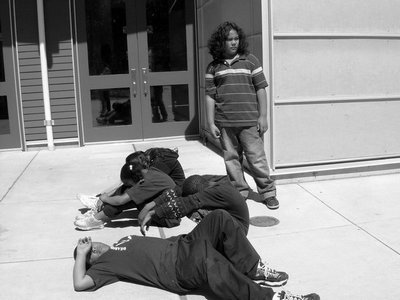May 24, 2007
Literacy Through Photography students to exhibit work Friday
The words and photographs work together like peanut butter and jelly, one making the other better.
On Friday, May 25, from 10 a.m. to 2 p.m. in Mary Gates Hall Commons, 19 fourth-graders from Seattle’s Dearborn Park Elementary School, along with 10 UW students, will exhibit 120 photos and writings they created as part of the Literacy Through Photography program.
“They’ve loved the work,” Dearborn Park teacher Lynn Livesley said of her pupils.
Since January, the children have met with the UW students once a week at the school. Both the young students and their UW tutors have used a method of writing, then photographing, then writing again developed by photographer Wendy Ewald at Duke University’s Center for Documentary Studies beginning in 1989. This year’s Literacy Through Photography exhibit is the second at the UW but the first with both elementary and UW students.
“We found that putting a camera in the hands of a child becomes a way of showing us their world in ways they can’t otherwise,” said Christine Stickler, director of The Pipeline Project, which connects UW students with learning opportunities beyond campus. The UW sent Stickler to Duke to learn about Literacy Through Photography from Ewald.
At Dearborn Park, students first learned the basics of digital photography — camera mechanics, lighting, perspective. They then talked about four themes: self, family, community and dreams. Before taking any photographs, however, they wrote about a theme and what they intended to image. Then they shot the photographs and wrote about the results.
Kids loved taking the cameras home, Livesley said. Few had known much about photography, but some showed their families what they’d learned.
The pictures let students and teachers share life beyond the classroom. Photos of Muslim prayer rugs, for example, showed Livesley parts of a student’s life she hadn’t known.
Nataly Bankson, an 18-year-old sophomore, saw photos of children with the grandparents and cousins they call their immediate family — an arrangement different from that of her family in Bellevue. Bankson, who did the work for a two-credit education course, also learned what it means to be a teacher: “Sometimes you just have to be the boss.”
Dearborn Park Elementary, in the south Beacon Hill section of Seattle, is a busy mix of cultures. Seventy percent of students speak a language other than English at home, and many of the families are new to America, Livesley said.
For such students, she said, writing can be extra hard, but photographs make it easier. “A meaningful photo can help the flow of words.”
The photos also reflect lessons. Underneath a picture of several students mugging with cups of water is a line from a child named Abdi: “We like the water cooler! Water is the most important thing in the world. We need it more than anything…”
To make the program happen, Stickler bought 25 digital cameras plus several printers with $5,000 from The Seattle Foundation. She’s seeking money for more cameras, and is also working with the Comparative History of Ideas program and the Office of Undergraduate Academic Affairs to send the Literacy Through Photography program to South Africa.



